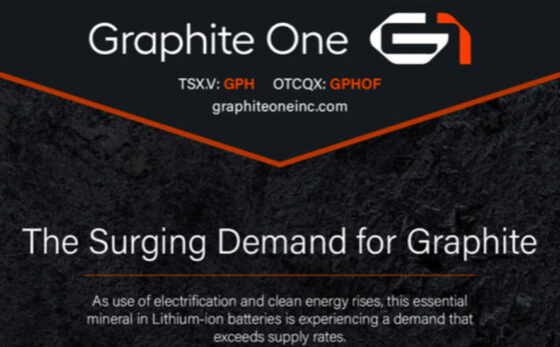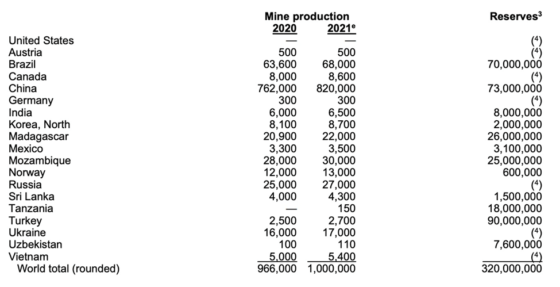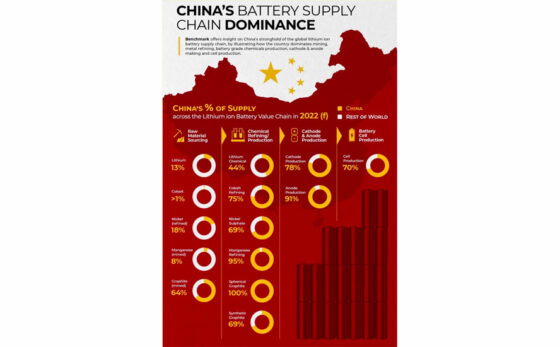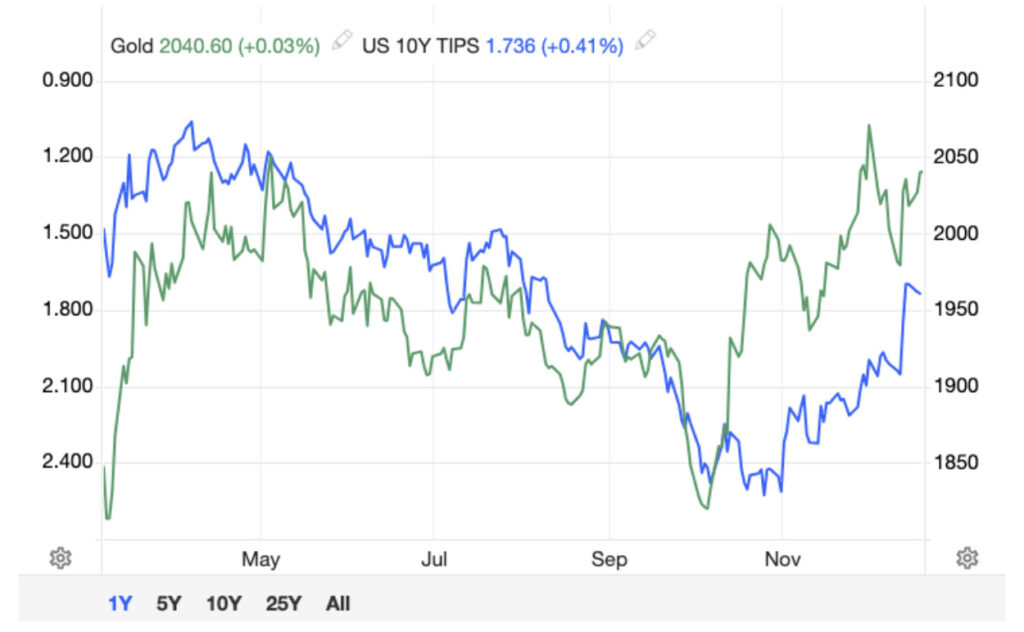Companies
The world needs more graphite, and the US needs Graphite One: Under the Spotlight with G1’s CEO Anthony Huston: Richard Mills
2022.11.01
The electrification of the global transportation system doesn’t happen without lithium and graphite needed for lithium-ion batteries that…

2022.11.01
The electrification of the global transportation system doesn’t happen without lithium and graphite needed for lithium-ion batteries that go into electric vehicles.
Graphite is included on a list of 23 critical metals the US Geological Survey has deemed critical to the national economy and national security.
An average plug-in EV has 70 kg of graphite. Every 1 million EVs requires about 75,000 tonnes of natural graphite, equivalent to a 10% increase in flake graphite demand.
A White House report on critical supply chains showed that graphite demand for clean energy applications will require 25 times more graphite by 2040 than was produced in 2020.
“Over the last decades, China has cornered the supply chain for batteries from critical mineral mining and processing to cathode anode belt manufacturing for critical minerals. For the critical minerals lithium, cobalt, graphite, nickel and manganese that are crucial to advanced batteries, China controls nearly all global processing capacity,” an official said, adding, “As the world transitions from a fossil fuel to a clean energy-powered economy, we cannot trade dependence on oil from autocrats like Putin to dependence on critical minerals from China.”
The US could be left in the dust as it continues to play catch-up in the EV race. For starters, natural graphite material is very difficult to source. Only about 20 countries make up the world’s supply, many of which produce insignificant amounts (<10,000 tonnes a year).

China is by far the biggest producer with nearly 80% of the world’s graphite production. Due to weak environmental standards and low costs, China also controls almost all graphite processing, establishing itself as a dominant player in every stage of the supply chain. After China, the next leading graphite producers are Brazil, Mozambique, Russia and Madagascar. The US, on the other hand, produces absolutely no graphite, and therefore must rely solely on imports to satisfy domestic demand; the country is 100% dependent on China for its battery-grade graphite.
Fortunately, the US government has begun taking a stand on US critical minerals vulnerability, including graphite.
On February 24, 2021, President Joe Biden signed an executive order aimed at strengthening critical US supply chains. Graphite was identified as one of four minerals considered essential to the nation’s “national security, foreign policy and economy.”
This year, the United States government invoked its Cold War powers by including lithium, nickel, cobalt, graphite and manganese on the list of items covered by the 1950 Defense Production Act, previously used by President Harry Truman to make steel for the Korean War.
To bolster domestic production of these minerals, US miners can now gain access to $750 million under the act’s Title III fund, which can be used for current operations, productivity and safety upgrades, and feasibility studies. The decision could also cover the recycling of these materials, according to Bloomberg sources.
The Biden administration has also allocated $6 billion as part of the $1 trillion infrastructure bill — towards developing a reliable battery supply chain and weaning the auto industry off its reliance on China, the biggest EV market and leading producer of lithium-ion cells.
State-directed funding for vehicle electrification has been made available through President Biden’s American Rescue Plan, a $1.9 trillion funding package to help US states, territories, cities and tribal governments replace tax revenue lost during the pandemic. According to a recent Bloomberg piece, hundreds of billions in federal aid was made available to states but never spent.
The Biden administration just made a major funding announcement regarding electric vehicles. The Department of Energy will award $2.8 billion in grants to 20 manufacturing and processing companies for projects across 12 states. The private sector is expected to match the government’s investment, leveraging the $2.8B for a total investment of $9 billion.
The projects are expected to “develop enough lithium to supply over 2 million electric vehicles annually and establish significant domestic production of graphite and nickel,” according to a fact sheet.
Meanwhile, global carmakers and established battery manufacturers have announced plans to invest at least $50 billion in a minimum of 10 states to build EV assembly and battery plants since the start of 2021, and states have made commitments totaling at least $10.8 billion to lure those investments.
US built batteries and EV’s galore
With all that is going on, it’s easy to lose sight of the big picture. The Center for Automotive Research provides some perspective.
The marketshare of all EVs, including full electrics, hybrids and fuel cell (hydrogen) vehicles, amounted to 12.2% in the first half of 2022, compared to 11.9% in 2021. If Biden’s targeted one-half of new light-duty vehicles being battery-electric and plug-in by 2030, is fulfilled, it would require roughly 8 million new EV batteries a year.
To enable manufacturers to give incentive rebates to consumers, new North American content rules make it imperative that EV content is American-sourced.
Remember: an average plug-in EV has 70 kg of graphite. Every 1 million EVs requires 70,000,000 kg of natural graphite.
To manufacture the battery packs for 2 million EV a year would require 140,000 tonnes of new graphite production a year.
In 2021 the US imported 50,000 tonnes of natural graphite, of which about 57% was flake and high-purity, 42% amorphous, and 1% lump and chip graphite. For round numbers, let’s say 50%, or 25,000 tonnes of battery-grade graphite, was imported (only high-purity flake graphite is suitable for EVs).
Getting from 50,000 tonnes to 140,000 tonnes would require an almost 3X increase in the amount of graphite the United States either imports or produces domestically, year on year. There are currently no producing US graphite mines and all of the country’s graphite processing is done overseas.
Where are we going to find the graphite?
To answer that question, I asked Anthony Huston, CEO of Graphite One (TSXV:GPH, OTCQX:GPHOF), to outline G1’s “parallel strategy” to simultaneously develop a battery anode materials manufacturing facility in Washington State and the Graphite Creek Mine in Alaska. Combined they are known as the Graphite One Project.
Manufacturing would begin with purchased materials until Alaska production is available. The company aims to become the first vertically integrated domestic producer to serve the nascent US electric vehicle battery market.
Richard Mills, Publisher/ Editor, Ahead of the Herd: The sourcing of critical metals has become a geopolitical issue. Both the United States and Canada now recognize, given an increasingly aggressive China and Russia, which control a lot of these metals, that they need to keep supply chains local. Could you please share your thoughts on geopolitics and the importance of developing local supply chains when it comes to graphite?
Anthony Huston, CEO, Graphite One: Geopolitics is a huge factor in critical minerals access and for graphite in particular. A supply chain is only as strong as its weakest link, and if an end-user in an industrialized nation is dependent on upstream supply from a graphite mine in a less stable, higher political-risk nation, with questionable transparency, lax labor and environmental standards, that end-user could find that supply interrupted by conflict or labor disputes, and face questions about exploitation of the mining workforce and environmental impacts. Whether it’s certainty of supply, national security or ESG concerns, there’s no substitute for a project in an industrial democracy, with all the standards and operational oversight. That’s the reality of 21st century resource development.
What G1 is hearing from major multinationals in the EV space is that they want to “silo” their supply chains. Graphite produced in Asia will be used to produce batteries for vehicles made in Asia; graphite produced in the US will be used in batteries manufactured in the US for American-made EVs.
For Graphite One, that means we are in a jurisdiction that combines the lowest political risk with the highest standards for ESG. With our mine-to-battery strategy, and with a battery recycling facility co-located at our graphite anode manufacturing plant in Washington State, that makes us a preferred partner, not only for EV makers, but for energy storage applications and energy grid upgrades as well.
RM: Could you please talk about the need for graphite in the US, and what Graphite One proposes to do about the current lack of domestic production?
AH: Let me provide some context that will show why I’m so confident that G1’s complete supply chain solution is the right one for Alaska and for America. The US is presently 100% import-dependent for its graphite needs, with the last US graphite mine shutting down more than 30 years ago.
That deep dependency will prevent the US from being a leader in the transition to renewable energy. The graphite supply chain is dominated by China. According to Benchmark Mineral Intelligence,
“While most of the world’s lithium, nickel, cobalt, and manganese for batteries is mined outside of China, the majority of all critical minerals for the battery supply chain are further refined and processed in China.
With the exception of mining, China controls at least half of the supply from every step needed to make a lithium-ion battery.”
The London-based price reporting agency and information provider notes that China mines 64% of natural flake graphite, and it has a “monopoly on converting [it] into the spherical graphite needed for anodes.”
It gets worse from there. Says Benchmark Mineral Intelligence:
“In 2022, Benchmark forecasts 70% of all batteries will be made in China. This is supported by strong control of the midstream, with a near monopoly over anode production and over three-quarters of cathode production.”

BMI recently quantified the supply gap in terms of how many new graphite mines the world would need at a typical rate of production. The number is 97 — 97 new mines, worldwide. Today the World Bank and the IEA project the global need for graphite will rise 494% between 2020 and 2050.
Not only has graphite been included on the US government’s Critical Minerals List, but earlier this year President Biden designated battery materials — including graphite — as “essential to the national defense” under the Defense Production Act of 1950.
And to bring it home to Graphite One, yet another US government agency – the US Geological Survey – reported this year that Graphite Creek is the largest graphite deposit in the United States.
G1 just completed a prefeasibility study (PFS) showing that, based on our exploration of just 7% of our full Graphite Creek deposit near Nome, Alaska, we show a pre-tax $1.9 billion net present value (NPV), a 26% internal rate of return (IRR), with a project life of 26 years. The average production over 26 years in the PFS is 75,026 tonnes of advanced graphite products per year.
So getting the US back in the graphite game, if we are serious about producing the EV batteries, rechargeable batteries for our laptops and smart phones and all manner of defense technologies, not to mention energy storage systems that can transmit wind and solar power to the national energy grid, will not happen without Graphite One.
That’s the need…
RM: What’s the current status of Graphite One’s proposal and timeline for development?
AH: Our plan involves not simply mining the graphite material, but building a complete US supply chain from mine to battery anode, and to complete the circular economy, adding a third link to the supply chain, recycling of spent batteries, to return that material to next-generation batteries for EVs and other devices.
And for G1 to do all that in the US, to reduce the risk of supply disruption, in a world that prioritizes ESG (environmental, social and governance), to ensure that what we do is done to the highest, most transparent standards.
In terms of the path ahead, our full PFS was formally filed on Oct. 13. Work is already underway on our feasibility study. Our plan is to advance Graphite Creek and our advanced materials processing plant simultaneously, to create a scenario where we can begin advanced materials manufacturing first, using purchased graphite feedstock, and phase in our Alaska graphite as soon as it is available.
RM: How has Graphite One’s proposal been received among top government officials?
AH: I’m proud of the fact that our efforts to develop our project so it aligns with key goals of public policy, have helped generate strong support from Alaska’s Governor Mike Dunleavy, who has made Alaska’s responsible development of critical minerals a key policy objective, and who frequently mentions Graphite One as a project of importance for Alaska. We’ve had strong support from Senator Lisa Murkowski, who has elevated the critical minerals issue in the Senate from her position on the Senate Energy & Natural Resources Committee. Also from Senator Dan Sullivan, who sits on the Senate’s Committee for Armed Services, and is the driving force behind a comprehensive US Arctic Strategy, which requires sustainable economic development in northern Alaska of the kind Graphite One — with North America’s largest graphite deposit — can provide.
RM: The White House just published its updated National Arctic Strategy, which mentions development of critical minerals in the Arctic. Do you have any thoughts about the importance of this and what it means for minerals production in Alaska?AH: G1 is pleased to see critical minerals listed as a formal strategic objective in the newly-released National Arctic Strategy. The fact is that US critical minerals policy depends in large part on Alaska, as a known resource of at least 45 of the 50 US Government-listed criticals, including graphite of course.
Looking at Graphite Creek in particular, the connection to a broader Arctic strategy is significant. If the goal is for the US to strengthen and maintain its presence in Arctic and near-Arctic Alaskan communities, you need a large, long-term driver of economic development to create the conditions for the investment in, and efficient development of infrastructure, energy sources, port maintenance and the like. That’s how the dual interest in strategic infrastructure and economic development in remote and, up to now, under-served communities has a new rationale. G1 is committed to working with the federal government, and also to be a good neighbor with local communities to make sure development creates opportunities for economic development in ways that respect traditional values.
RM: ESG is a buzzword in the mining industry these days. What is Graphite One doing to engage local communities?
AH: We value our communications with the local communities nearest Graphite Creek — Teller, Brevig Mission, Mary’s Igloo and the City of Nome — to understand how we can be a good neighbor, bringing jobs, opportunity and economic growth to the region, with respect for the traditional ways and traditional values.
And we’ll bring the same approach to our processing and recycling facilities in Washington State, working with the state’s federal officials, with the governor, and with the local communities near our facilities. G1 is going to bring a long-term, reliable source of a critical material for renewable energy, advanced technologies and national security, and we’re going to do it in a responsible way.
RM: The Inflation Reduction Act encourages the development of a domestic supply chain for critical minerals to be used in electric vehicles. How does the passage of the IRA affect Graphite One? Do the incentives in the new law change the economics of Alaska graphite mining in any way?
AH: The act passed as we were days away from completing our PFS, and the Treasury Department has yet to issue the detailed guidance, so we can’t model an exact dollar impact, but there is absolutely no question the impact for G1 will be positive and significant.
The Advanced Manufacturing Production Credit provides a 10% tax credit for “electrode active material” — anodes — and an “applicable critical mineral” – such as graphite, if purified to 99.9%. G1 plans to produce both.
The tax credit phases out to zero over the period 2029-2032, but there is no phase out for applicable critical minerals. It’s the kind of strong signal markets have been looking for that shows criticals like graphite are seen as strategic by the US government.
In addition to the 10% tax credit, the Clean Vehicle Tax Credit provides a $3,750 credit to EV purchasers of cars with qualifying battery components. This is phased-in to the maximum rate by 2026. It should provide an added incentive to EV makers to purchase our material, and it aligns perfectly with G1’s strategy to build a complete US-based advanced graphite supply chain.
RM: Walk me through the graphite supply chain as you envision it. Where will the graphite powder and concentrate the Graphite Creek Mine expects to produce go, after it leaves the mine? What route will it take to processing and the markets beyond?
AH: With our complete supply chain solution, G1 isn’t exiting the market by selling a graphite concentrate and leaving it at that. We are producing an advanced graphite material, suitable for EV batteries, which is nearly a 10X increase in value-add over selling graphite concentrate.
That puts G1 upstream for key end-users in the EV/automotive sector, consumer and computing sectors. Add our recycling capability, and we come full-circle: recapturing spent battery materials for a second life, to be used in next-gen technologies.
In this way, Graphite One isn’t simply a mining company. We’re a technology company that mines graphite.
As for the transportation route between our supply chain links, Alaskan graphite will be barged to a Washington port and trucked or railed to our advanced materials manufacturing plant.
Barging between Seattle and the Alaska coast is a regular seasonal event, conducted by experienced transportation companies.
We will manufacture our advanced graphite products – anodes and more – and ship them to our customers by truck or rail. End to end, all in the United States.
And finally, to complete the circle, we’ll take in spent EV batteries, recycle battery materials and give them a second life as battery-ready materials.
RM: How many workers do you expect Graphite One to employ at the height of production?
AH: Our just-completed PFS projects that employment at full capacity, of the first two links in the G1 supply chain — our mine and processing facility at Graphite Creek in Alaska, plus our advanced graphite materials manufacturing plant in Washington State — will require just under 400 employees.
We are working now to estimate job requirements for our planned recycling facility, to be co-located at the Washington State site, with the number fluctuating according to the speed of the operation.
So the 400 jobs are a floor, not a ceiling, and given the compensation for mining jobs and the need for highly-skilled employees across our full supply chain, these are well-paid, permanent jobs, in parts of Alaska and Washington State where un- and under-employment is a serious issue. And I didn’t mention the jobs we will create without underscoring our local preference for hiring and G1’s commitment to training, so our people can build their skill-sets and move up to new opportunities as we operate our project. That’s why I say that G1 has great “opportunity impact.”
To connect G1 employment opportunities with the point I made earlier about our 26-year project life based on exploration of just 7% of our total deposit, G1 is going to be around for a long time. As a good neighbor within the communities we operate, we want local people who join G1 to know they can grow with us.
RM: How much of a challenge is it to access the mine? To what degree does it cross federal land (BLM, NPS, etc.)?
AH: G1’s Graphite Creek Mine is 100% on Alaska state land — there’s no BLM or National Forest Service land involved in our project. That said, G1 is committed to full compliance with every Alaska state and federal requirement. We intend to make this a model project — a critical minerals project essential to the renewable energy revolution and to national security, done in the right, responsible way.
As for access, given that the Graphite Creek deposit is not situated on existing infrastructure, we will need to build an 18-mile access road to reach the site. We are looking at options for the access road that meet community interests in making sure subsistence activities remain sustainable.
RM: It sounds like a fascinating project. Thank you for speaking with me today, and updating my readers on your progress to date.
AH: Thank you, Rick, it was my pleasure.
Richard (Rick) Mills
aheadoftheherd.com
subscribe to my free newsletter
Legal Notice / Disclaimer
Ahead of the Herd newsletter, aheadoftheherd.com, hereafter known as AOTH.
Please read the entire Disclaimer carefully before you use this website or read the newsletter. If you do not agree to all the AOTH/Richard Mills Disclaimer, do not access/read this website/newsletter/article, or any of its pages. By reading/using this AOTH/Richard Mills website/newsletter/article, and whether you actually read this Disclaimer, you are deemed to have accepted it.
Any AOTH/Richard Mills document is not, and should not be, construed as an offer to sell or the solicitation of an offer to purchase or subscribe for any investment.
AOTH/Richard Mills has based this document on information obtained from sources he believes to be reliable, but which has not been independently verified.
AOTH/Richard Mills makes no guarantee, representation or warranty and accepts no responsibility or liability as to its accuracy or completeness.
Expressions of opinion are those of AOTH/Richard Mills only and are subject to change without notice.
AOTH/Richard Mills assumes no warranty, liability or guarantee for the current relevance, correctness or completeness of any information provided within this Report and will not be held liable for the consequence of reliance upon any opinion or statement contained herein or any omission.
Furthermore, AOTH/Richard Mills assumes no liability for any direct or indirect loss or damage for lost profit, which you may incur as a result of the use and existence of the information provided within this AOTH/Richard Mills Report.
You agree that by reading AOTH/Richard Mills articles, you are acting at your OWN RISK. In no event should AOTH/Richard Mills liable for any direct or indirect trading losses caused by any information contained in AOTH/Richard Mills articles. Information in AOTH/Richard Mills articles is not an offer to sell or a solicitation of an offer to buy any security. AOTH/Richard Mills is not suggesting the transacting of any financial instruments.
Our publications are not a recommendation to buy or sell a security – no information posted on this site is to be considered investment advice or a recommendation to do anything involving finance or money aside from performing your own due diligence and consulting with your personal registered broker/financial advisor.
AOTH/Richard Mills recommends that before investing in any securities, you consult with a professional financial planner or advisor, and that you should conduct a complete and independent investigation before investing in any security after prudent consideration of all pertinent risks. Ahead of the Herd is not a registered broker, dealer, analyst, or advisor. We hold no investment licenses and may not sell, offer to sell, or offer to buy any security.
Richard owns shares of Graphite One (TSX.V:GPH). GPH is a paid advertiser on his site aheadoftheherd.com
tsx
tsxv
otcqx
ax
lithium
cobalt
manganese
nickel
tsxv-gph
graphite-one-inc

Dolly Varden consolidates Big Bulk copper-gold porphyry by acquiring southern-portion claims – Richard Mills
2023.12.22
Dolly Varden Silver’s (TSXV:DV, OTCQX:DOLLF) stock price shot up 16 cents for a gain of 20% Thursday, after announcing a consolidation of…
GoldTalks: Going big on ASX-listed gold stocks
Aussie investors are spoiled for choice when it comes to listed goldies, says Kyle Rodda. Here are 3 blue chips … Read More
The post GoldTalks: Going…
Gold Digger: ‘Assured growth’ – central bank buying spree set to drive gold higher in 2024
Central banks will drive the price of gold higher in 2024, believe various analysts Spot gold prices seem stable to … Read More
The post Gold Digger:…
















